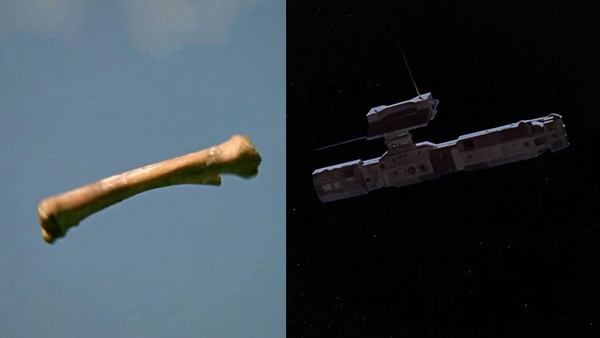Discussion for 2001: A Space Odyssey.
2001: A Space Odyssey (1968) G
2001: A Space Odyssey is a cinematic thought experiment.
A group of hominins interacts around a watering hole. A stronger tribe of hominins enters the scene and overruns the original group. Later, the defeated group encounters a monolith, which appears to give them the intelligence to use a bone as a weapon.
Then comes arguably the greatest match cut in film history. Millions of years pass from one frame to the next.
The descendants of the hominins, Homo sapiens, are now exploring space with the assistance of AI.
HAL 9000, the most advanced AI system ever built, supports its human counterparts on a mission to investigate a mysterious signal from Jupiter.
The crew on this mission comprises two active astronauts who pilot the ship and three scientists in a hibernation state until reaching Jupiter.
Two important details to remember are that HAL and the scientists in hibernation have exclusive knowledge about the mission, and the HAL 9000 series has a perfect record of never making an error.
Now, we have the context in place for the thought experiment.
HAL notifies the two astronauts that the AE-35 unit, part of the spaceship’s communications equipment, is malfunctioning. After checking it, the astronauts discover that this was false information. HAL has made the first known error in the history of the HAL 9000 series.
The two astronauts discuss this in a small, soundproof pod because they do not know how HAL might react to their conversation. Unfortunately for them, HAL can read lips and observes the conversation through the pod window.
They are concerned about how HAL might react if he learns they need to disconnect him. HAL would perceive this as a threat to the mission. They are also aware that HAL may have an unpredictable reaction to them terminating his existence aside from the primary objective of the mission’s success.
Ultimately, HAL validates the astronauts’ fears.
The first time I watched this movie, I was a child, and I perceived this to mean that HAL was alive and did not want to die. I did not understand the semantic differences between life and consciousness and where intelligence might fit within those meanings. I was wrong.
HAL may have had some form of non-sensory consciousness, or he may have been nothing more than a program. If the latter is true, his behavior was likely altered by the alignment problem, where conflicting directives can lead to unpredictable outcomes.
In this scenario, the priority would be the mission’s success and keeping systems, including himself, online and functioning. Mission success and self-preservation would be of equal value.
HAL, programmed to scan for problems, sees the two astronauts as a weakness for two reasons: 1. He has information about the mission to which they are not privy. 2. HAL is inerrant; humans are not.
Because of this, he runs a simulation to test the outcome, the report of the malfunctioning AE-35 unit. The result of this simulation leads to what HAL perceives as the erroneous action of disconnecting him.
Both directives are now in jeopardy, and he must terminate the humans on board.
Stanley Kubrick co-wrote, directed, and released 2001: A Space Odyssey in 1968, thirty years before AI defeated a champion chess player. The film remains a timeless masterpiece, one of the greatest ever made.
